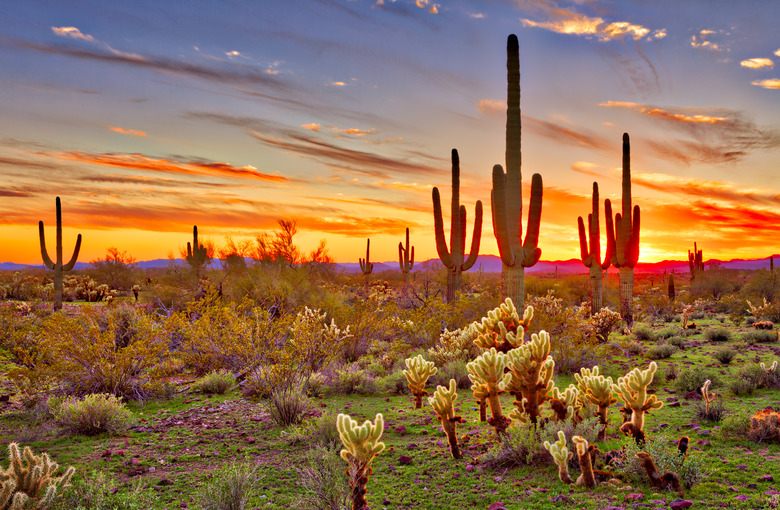Advantages & Disadvantages Of Deserts
Deserts have the the driest climates, but they still support life. They cover one fifth of the planet and get little rainfall. However, plants and animals have learned to adapt to the difficult climate and survive the extreme conditions. Read on to learn more about desert life, the advantages and disadvantages of deserts.
Advantage: Habitat for Specialized Flora and Fauna
Advantage: Habitat for Specialized Flora and Fauna
One of the advantages of deserts is that they are home to a diverse group of plants and animals. They are especially adapted for survival in the desert through their efficient use of water. Specialized plant features include thick, waxy leaves and large root or water storage systems, which contribute to their high resistance to drought. Examples of thriving desert plants include various cactus species, prickly pears, yuccas and agaves. A combination of unique evolutionary traits, which include both physical and behavioral features, makes the survival of desert animals possible. Examples include the jackrabbit's large ears for heat regulation, the spadefoot toad's hibernation during the driest months, and accelerated breeding among various desert insects and amphibians. Several species are nocturnal, allowing them the best use of the desert's coolest hours.
Advantage: Abundance of Soil Nutrients
Advantage: Abundance of Soil Nutrients
Because most deserts receive little to no rainfall and contain no subsurface water, soils have fairly low salt concentrations — a feature highly favorable for desert plant growth. Depending on the type of desert, soil types range from fine-textured sands to gravel and loose rock. Desert soil holds an abundance of nutrients because of the minute amounts of rainfall and surface runoff, and therefore lends itself easily to agricultural use, provided that an efficient irrigation system is developed.
Disadvantage: Lack of Water
Disadvantage: Lack of Water
Lack of water, the most evident disadvantage to deserts in general, results from the combined effects of insufficient rainfall and rapid water evaporation by nearby land masses. The rate of rainfall rarely exceeds the rate of evaporation, and it is not uncommon for rain to vaporize even before hitting the ground. The Atacama Desert in Chile, known as the driest place on Earth, receives less than 1 inch of rain per year, and some years gets virtually none at all. This is because of moisture blockage and draw-off by the Andes and the Chilean Coast mountain ranges. Though fairly seasonal, desert rainfall is unpredictable and very localized.
Disadvantage: Extreme Weather Conditions
Disadvantage: Extreme Weather Conditions
Compared with more humid regions, deserts lack the temperature-buffering effects of water vapor, exposing them to more than twice the amount of solar radiation during daylight hours and to the loss of nearly twice as much heat come nighttime. Daily temperature extremes in arid deserts reach up to 130 degrees Fahrenheit at the sun's peak and plummet below freezing in some locations. Other less frequent weather disturbances include sudden wildfires and intense, flood-causing rains.
Cite This Article
MLA
Johnson, Steve. "Advantages & Disadvantages Of Deserts" sciencing.com, https://www.sciencing.com/advantages-disadvantages-deserts-8355586/. 23 April 2018.
APA
Johnson, Steve. (2018, April 23). Advantages & Disadvantages Of Deserts. sciencing.com. Retrieved from https://www.sciencing.com/advantages-disadvantages-deserts-8355586/
Chicago
Johnson, Steve. Advantages & Disadvantages Of Deserts last modified March 24, 2022. https://www.sciencing.com/advantages-disadvantages-deserts-8355586/
